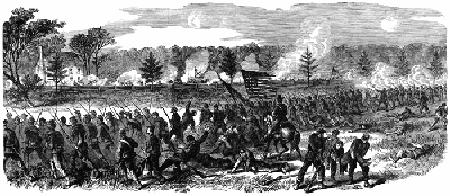The David Whitney Story
Part II – Chapter 5
David's Military Service
Section 8
The Overland Campaign – Cold Harbor
Cold Harbor's Strategic Location
Cold Harbor was an old tavern standing at the junction of five separate roads. This location was strategically important in any advance on Richmond, because the Union command had established its main supply base further down the Pamunkey River in New Kent County at White House Landing, allowing resupply access up the river from the Chesapeake Bay. Cold Harbor stood on the direct route from the Union supply base to their troops in the field.
On May 31, 1864, a Union cavalry unit was sent to take Cold Harbor but found Confederate infantry already setting up a defensive line there. However, after dismounting, the cavalry troops managed to take control of the crossroads.
Union reinforcements were then proceeding from two directions. One contingent of troops were coming up the Chesapeake from their position below Richmond and would approach Cold Harbor from White House Landing to the east. From the west, the 6th Corps, which—including David Whitney's 10th Vermont Regiment—had been pulled from their position at the extreme right (west) flank of the Union lines along the Pamunkey, were marching stealthily but swiftly behind those lines toward Cold Harbor.
At the Forefront of Two Assualts
After a 15-mile march, the 6th Corps reached Cold Harbor on June 1. Late that afternoon, the Union command launched a frontal attack on the Confederate entrenchment with the 6th Corps in position on the right. David's regiment had to advance through pine woods, over a plowed field, through swampland, and up an embankment to the Confederate trenches. As dusk settled in, David and his comrades charged the Confederate position in front of them and breached their lines with much fierce fighting. The Confederates at that position then surrendered with at least 600 of them passed back as prisoners through the 10th Regiment's lines to other Union forces at the rear.

Image courtesy of FCIT Clipart Collection.
Cold Harbor
The 10th Regiment regrouped and were advancing again, when their remaining Confederate opponents charged. The 10th Regiment hit the ground and, returning the fire, managed to drive off their attackers. By this time, around 9:00pm, David's Company G and two other companies had gotten separated from the rest of their regiment. As they waited for orders from their regiment command, they were approached by a line of soldiers whose identity wasn't clear in the dark.
After a short while, two members of the approaching line stepped forward and ordered David and his comrades to surrender. The 10th Vermonters again hit the dirt, but neither side used their weapons. Both sides called back and forth to each other to surrender, and the Confederate line kept advancing a little at a time. Finally the Vermonters fired shots, and their opponents withdrew. David and his comrades then moved off quietly but were the last to leave the field that night.
During the fighting on June 1, the 10th Regiment took several casualties, including two officers killed in action, one of which was a lieutenant from David's Company G. The regiment's commander was wounded and was replaced by his Executive Officer.
The following day, skirmishing and artillery fire were used in preparation for a massive frontal assault the next day. On June 3, David's unit was in the center of the 6th Corps assault and, although being driven back, managed to hold a position 40 yards from the Confederate entrenchment. In this, their second major engagement at Cold Harbor in three days, the 10th Vermont Regiment again took heavy losses at the forefront of very bloody combat.
A Deadly Toll
Union forces as a whole took severe losses in their unsuccessful assaults these two days, Wednesday, June 1 and Friday, June 3. No more such grand maneuvers were undertaken at Cold Harbor, and both sides dug in facing each other. From June 4 to June 12 there were minor attacks, artillery shelling, and sniping by sharpshooters.
In the overall conflict at Cold Harbor, Union forces suffered 12,000 casualties, including the killed, wounded, missing, and captured. David's regiment had 30 killed, 47 wounded, two captured, and two missing and unaccounted for. Of the 47 wounded, 17 died subsequently from the effects of their wounds. David survived this fierce battle unscathed and was one of 364 men now remaining in the 10th Vermont Regiment.
©2007 by Thomas Lee Eichman. All rights reserved.